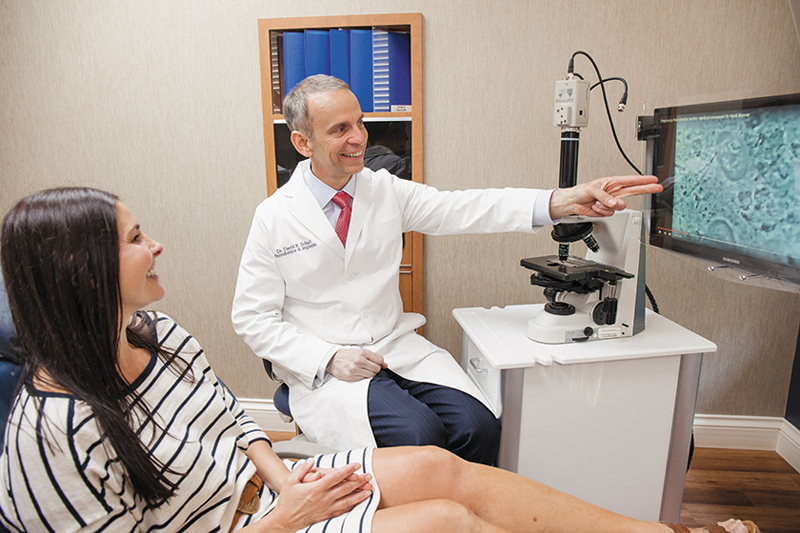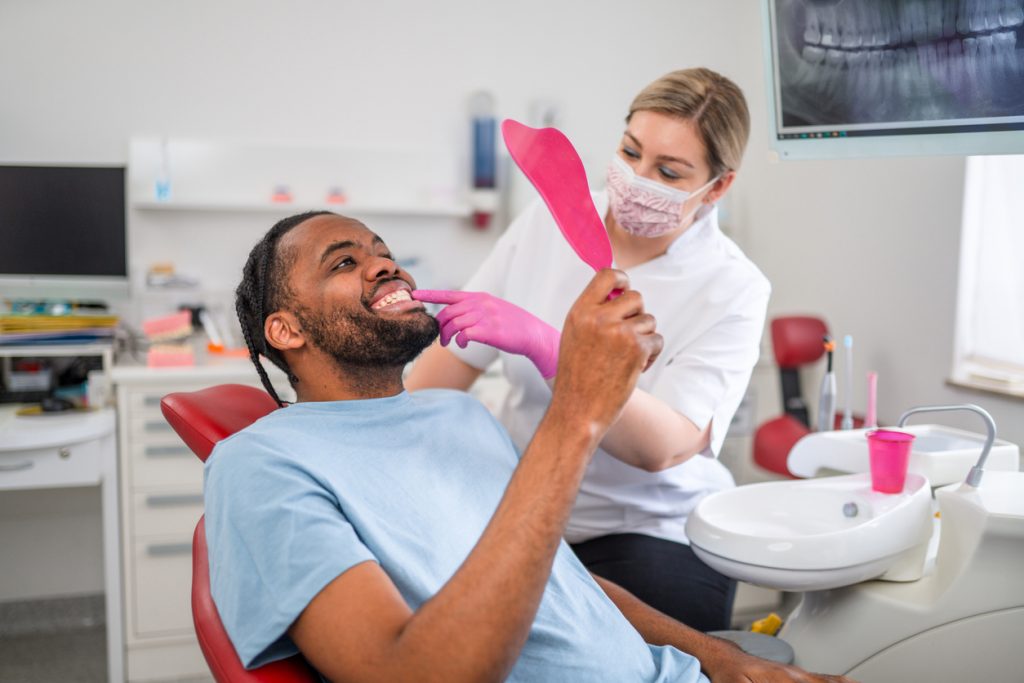
Periodontal Pocket Reduction in Long Island, NY
Click above to see reviews.

Periodontal Pockets Can Lead To Tooth Loss

A staggering 47% of Americans currently struggle with some form of periodontal disease. What causes periodontal disease? The main cause of periodontal disease is a sticky, colorless plaque that forms on the teeth.
Both teeth and gums must be healthy for them to function correctly. Failure to care for the teeth and gums can cause the gums to start receding and pulling away from the teeth. When this occurs, there are measurable small periodontal pockets. If gum disease worsens, these pockets become infected and can stop supporting the teeth properly causing shifting and tooth loss.
Put a stop to periodontal pockets and get your health back. Call Dr. Scharf for an appointment.
The Risks of Periodontal Pockets

On average a normal periodontal pocket has a depth of 2-3 millimeters. When bacteria start to accumulate around the teeth and are not completely cleaned away daily, they can start to attack the gums and teeth, increasing infection concerns under the gum tissue.
The teeth need to be supported by the gums or they will begin pulling away from the teeth. These periodontal pockets will continue to provide a larger space for the bacteria to continue thriving. As the bacteria advances, it will also start infecting the bone tissue, which can lead to serious oral health problems.
When a periodontal pocket reaches a depth of 5 millimeters, it is cause for concern. The larger pockets are concerning as they have a large build-up of bacteria that need professional removal. Failure to have the pockets cleaned can lead to tooth extractions over time. Bone loss is the largest concern as it can lead to expensive and painful dental procedures. Patients often need to have multiple surgeries to reverse the problems the bacteria cause. Dental extractions and bone grafting are some of the most common procedures following periodontal disease.
Don’t risk it. Get your dental health back and keep your smile looking its best.
LANAP: Better Than Pocket Reduction Surgery

Many periodontists perform pocket reduction surgery, but Dr. Scharf has a better way of cleaning a healing gum disease. He uses Laser Gum Therapy or LANAP (Laser-Assisted New Attachment Procedure).
First, Dr. Scharf will measure the depth of the pockets surrounding the teeth to determine the level of treatment needed. LANAP or laser gum therapy is recommended for patients with pockets that are too deep to clean at home and require additional professional care to clean them.
During the procedure, Dr. Scharf will measure the pockets and apply anesthesia to the gum tissue to reduce pain. Dr. Scharf will then use a specialized laser to clean the pockets between the teeth and gum tissue. The procedure only kills the bad bacteria. There can be additional needs for patients with damaged teeth that require smoothing. Irregular surfaces are breeding grounds for bacteria, and you can see an increase in bacteria when the tooth is not smooth.
The LANAP laser encourages the gum tissue to reattach to the tooth, and the mouth should begin healing immediately. It is common to have tenderness and slight discomfort for a few days following LANAP. However, patients will receive at-home care instructions such as gargling with warm salt water to speed up the healing process.
We use antimicrobial liquid to eliminate bacteria in the mouth. The liquid is designed to improve the healing process and prevent bacteria from re-entering the pockets and causing infection to spread. The healing time can be as little as 24 hours and as long as 10 days depending on the extent of treatment and how well the patient follows aftercare instructions.
Reducing the pocket depth and eliminating the bacteria in the mouth is vital to preventing damage caused by the progression of periodontal disease. Eliminating bacteria may not be enough to prevent future problems with periodontal disease. Working with Dr. Scharf is the best way to ensure ongoing treatment occurs to aid in preventing additional problems. Deeper pockets are those that will need regular cleaning and maintenance by professionals to prevent bacteria from advancing further.
Let’s get your gums back to health. LANAP is a revolutionary, less invasive procedure with amazing results. Schedule an appointment with Dr. Scharf today.

What Are the Benefits of Periodontal Pocket Reduction?
Pocket reduction treatment using LANAP eliminates bacteria, reduces inflammation, and prevents bone loss. Patients in need of periodontal treatment normally are at-risk for teeth loss due to infection compromising the bone and gums. Here are some of the reasons why pocket reduction treatment using LANAP is the best option:
- Reducing bacterial spread – Keeping oral bacteria under control will reduce problems with other health conditions like heart disease, diabetes, and strokes. Oral bacteria is connected to several areas of the body, all of which need bacteria controlled to reduce the risk of secondary infections.
- Reducing bone loss – Halting bone loss is vital to reducing serious concerns that require bone grafting. Bone loss can impact your jawbone, which leads to changes in your appearance as the bone continues to deteriorate. Another concern with bone loss means speech issues along with eating problems. Teeth that become too loose because of jawbone and gum disease problems can start to fall out, or they will need to be extracted.
- Easier oral healthcare – Following LANAP laser gum surgery, patients will be able to see an improvement in their at-home oral healthcare needs. When the pockets are clean, daily dental brushing and flossing will reduce the risk of additional infection.
- Improved smile – A healthy smile has been shown to boost confidence and increase self-esteem. Oral cavities that are impacted by periodontal disease are an eyesore. Smiles with periodontal disease can have cosmetic issues like brown gums and rot surrounding the teeth and ridges. Don’t let your smile be impacted by gum disease, opt for pocket reduction treatment using LANAP to improve the aesthetics of your smile!
Experience the benefits of LANAP on your dental health and your smile. Call to schedule with Dr. Scharf, today.

What Is Periodontal Regeneration?
Damage occurs when periodontal disease continues to go untreated. Sometimes the damage causes problems with the bone, and it is too deep to smoothen in a standard treatment. Periodontal regeneration will help to re-grow the supporting structure of the tooth, allowing for the mouth to become healthy again. Bone grafting, guided tissue regenerative membranes, and tissue stimulating proteins are all used to help encourage the body to heal itself and begin re-growing gum tissue and strengthening the jawbone.

Does Periodontal Pocket Reduction Treatment Hurt?
LANAP is a relatively painless procedure. Most patients drive themselves home or back to work right after treatment.
Our goal is to help our patients finally feel proud of their smiles while also avoiding pain and invasive dental procedures like tooth extractions.
Discuss your concerns with Dr. Scharf so we can help you to be as comfortable as possible.
How Long Will It Take to Heal?
Patients can expect to return to their normal routine in about a day or less. Of course, it depends on how your body reacts to treatment, and how long your body normally takes to heal. Patients with additional health problems may see an extra day or two added to the healing time. Discuss post-operative treatments with our staff. We make sure your questions are answered and your treatments are as comfortable as possible.
To schedule your appointment for periodontal pocket reduction treatment using LANAP, please contact us today. Don’t wait until your gum disease worsens, call now to make an appointment to prevent the bacteria from spreading, and be happy to share your smile!
Long Island Pocket Reduction Surgery
ADDRESS:
98 East Main Street
Babylon, NY 11702
Get Directions
PHONE: (631) 661-6633
OFFICE HOURS:
- Monday: 11:00 AM to 8:00 PM
- Tuesday: 9:00 AM to 8:00 PM
- Wednesday: 8:00 AM to 5:00 PM
- Thursday: 8:00 AM to 5:00 PM
- Friday: 8:00 AM to 5:00 PM
